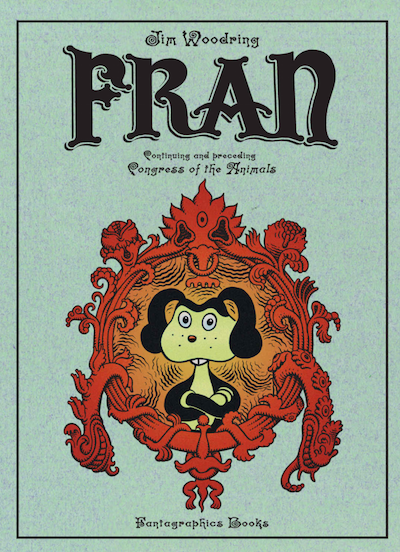This was the third book in the Frank series of unpredictable wordless comics that I have had the chance to read so far. It’s a bit newer compared to almost all the other books in the series, which cartoonist Jim Woodring started pumping out more than 25 years ago. Fran was published in 2013, and it features Frank’s soulmate (named Fran), who was a new character to me. Allegedly, it is somehow simultaneously both the prequel and the sequel to Woodring’s 2011 book Congress of the Animals, but I haven’t read that one yet.
A typical Frank comic takes the reader along for one of Frank’s kooky misadventures after another. The books are usually set in the Unifactor, which is the alien landscape that Frank inhabits. However, Frank apparently left his home in Congress of the Animals for uncharted lands, where he ended up finding and wooing Fran.
In Fran, the two lovebirds start their day with ample cordiality, but they end up getting into a heated lover’s quarrel and Fran sets off to have some alone time. She embarks on a hair-raising solo adventure, seemingly untouchable by an array of dangers, even though she comes across several would-be threatening and intimidating creatures and situations.
Heartbroken and regretful for his actions during the fight, Frank and his two adorable pets Pupshaw and Pushpaw follow Fran’s tracks in an effort to find her. Along the way, Frank travels through time and space to otherworldly locales and ends up confronting a mirror version of himself in a random house. While all of this is happening, Fran is off lackadaisically enjoying herself in her own happy-go-lucky way.
As I found in the other books of his, Woodring’s unique sense of humor is quirky and playful in Fran, with an spiritual undercurrent running throughout every page of the book. I love this funny quote from the inside of the dust jacket:
So do yourself a favor and take the plunge. You can’t stay cooped up on the outside of this book forever!
I got a good chuckle out of that. And it’s not too often that I laugh even before I start reading a book!
So what did I think about Fran? Worry not—it’s another mindbending Woodring masterpiece and I thoroughly enjoyed the ride it took me on. However, I didn’t like it quite as much as the other Frank comics I have read—Weathercraft and The Portable Frank. In fact, if you’re considering taking a plunge into this world, I’d suggest you start with one of those two instead. Similar to Weathercraft (and Congress of the Animals), Fran features one long narrative instead of several vignettes.
Aside from comparing it to other books in the series, Fran is an awesome story and definitely worth checking out. No matter which one you start with, you can’t go wrong—there’s nothing quite like Jim Woodring’s Frank series.
3/5 stars. 120 pages.
If you enjoyed this post, you might also enjoy my reviews of Weathercraft and The Portable Frank.










